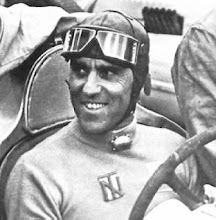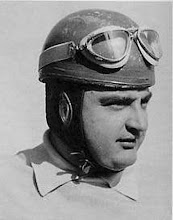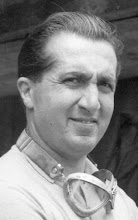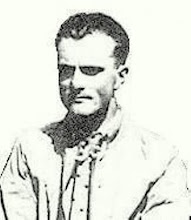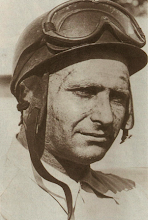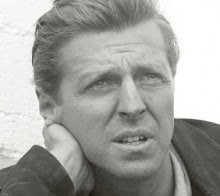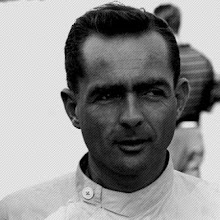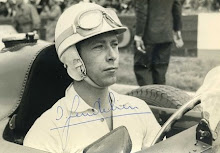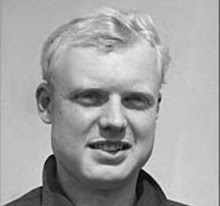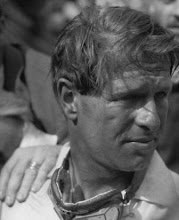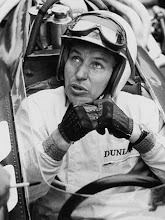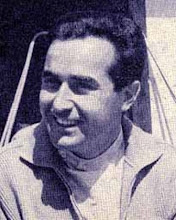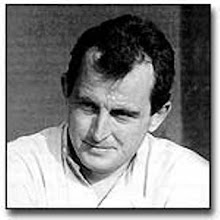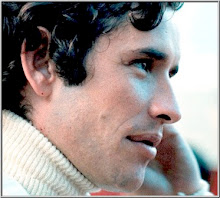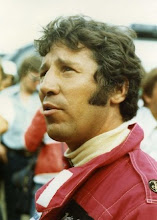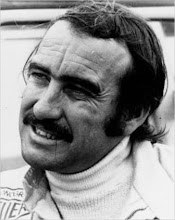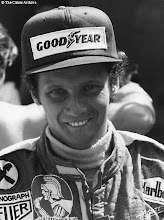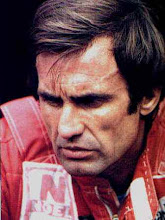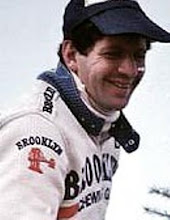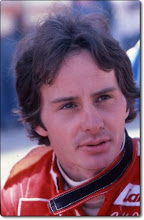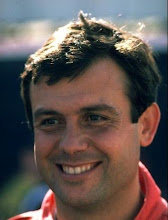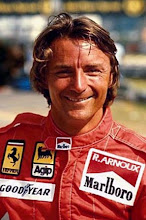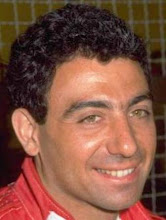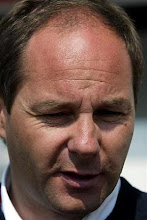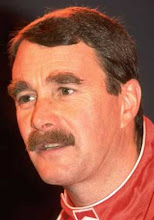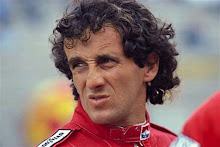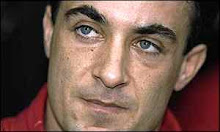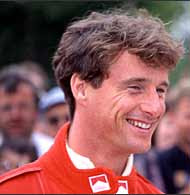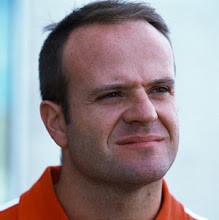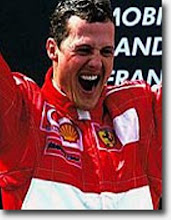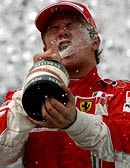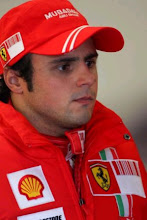 The 1964 World Championship went right down to the wire, at Mexico City. Jim Clark could have won, but the battle was really between John Surtees and Graham Hill. Hill clashed with Surtees' Ferrari teammate Lorenzo Bandini, forcing Hill to pit for repairs. This meant that Surtees' second place behind Dan Gurney's Brabham was enough to claim the title. Earlier in the season, Surtees in the Ferrari 158 negotiates the Karrussell at the Nurburgring on his way to victory in the German Grand Prix.
The 1964 World Championship went right down to the wire, at Mexico City. Jim Clark could have won, but the battle was really between John Surtees and Graham Hill. Hill clashed with Surtees' Ferrari teammate Lorenzo Bandini, forcing Hill to pit for repairs. This meant that Surtees' second place behind Dan Gurney's Brabham was enough to claim the title. Earlier in the season, Surtees in the Ferrari 158 negotiates the Karrussell at the Nurburgring on his way to victory in the German Grand Prix. The 1964 World Championship went right down to the wire, at Mexico City. Jim Clark could have won, but the battle was really between John Surtees and Graham Hill. Hill clashed with Surtees' Ferrari teammate Lorenzo Bandini, forcing Hill to pit for repairs. This meant that Surtees' second place behind Dan Gurney's Brabham was enough to claim the title. Earlier in the season, Surtees in the Ferrari 158 negotiates the Karrussell at the Nurburgring on his way to victory in the German Grand Prix.
The 1964 World Championship went right down to the wire, at Mexico City. Jim Clark could have won, but the battle was really between John Surtees and Graham Hill. Hill clashed with Surtees' Ferrari teammate Lorenzo Bandini, forcing Hill to pit for repairs. This meant that Surtees' second place behind Dan Gurney's Brabham was enough to claim the title. Earlier in the season, Surtees in the Ferrari 158 negotiates the Karrussell at the Nurburgring on his way to victory in the German Grand Prix. Right from the start of the first season of the new 1.5 litre formula, it was obvious that Ferrari was the class of the field with their 156 'Sharknose' car. Phil Hill and Wolfgang von Trips would fight out the world championship, with the only resistance coming from Stirling Moss. It all came to a tragic end at Monza, when von Trips flew into the crowd after a clash with Jim Clark, killing the German von Trips. It made Phil Hill the first American World Champion. Here Hill is at Zandvoort in Holland, on his way to second place behind von Trips.
Right from the start of the first season of the new 1.5 litre formula, it was obvious that Ferrari was the class of the field with their 156 'Sharknose' car. Phil Hill and Wolfgang von Trips would fight out the world championship, with the only resistance coming from Stirling Moss. It all came to a tragic end at Monza, when von Trips flew into the crowd after a clash with Jim Clark, killing the German von Trips. It made Phil Hill the first American World Champion. Here Hill is at Zandvoort in Holland, on his way to second place behind von Trips. During the 1959 and 1960 seasons, the small rear-engined Cooper Climaxes swept all before them, heralding a revolution in racing car design. The only front engined resistance came from Ferrari. So it was somewhat fitting that Ferrari took the last front engined victory. In the pits, awaiting combat, is Phil Hill in the race winning Ferrari Dino 246.
During the 1959 and 1960 seasons, the small rear-engined Cooper Climaxes swept all before them, heralding a revolution in racing car design. The only front engined resistance came from Ferrari. So it was somewhat fitting that Ferrari took the last front engined victory. In the pits, awaiting combat, is Phil Hill in the race winning Ferrari Dino 246.
 was a bittersweet year for Ferrari. Mike Hawthorn won the first post-Fangio title by one point from Stirling Moss, but Ferrari lost Peter Collins, dying in a crash at the Nurburgring. With his best mate gone, Hawthorn felt he could no longer continue. Weeks after becoming champion, Hawthorn died after a crash in a Jaguar on a wet public road. Here Hawthorn steers a Dino 246 tat Silverstone.
was a bittersweet year for Ferrari. Mike Hawthorn won the first post-Fangio title by one point from Stirling Moss, but Ferrari lost Peter Collins, dying in a crash at the Nurburgring. With his best mate gone, Hawthorn felt he could no longer continue. Weeks after becoming champion, Hawthorn died after a crash in a Jaguar on a wet public road. Here Hawthorn steers a Dino 246 tat Silverstone.
 Ferrari's third drivers championship was won by the Maestro, Juan Manuel Fangio. Here Fangio drives the Ferrari D50 that Lancia built, at the Nurburgring Nordschleife, to collect Ferrari's 25th World Championship win. In the absence of teams from Mercedes and Lancia, Ferrari only had Maserati to beat, and with Fangio on board how could they fail?
Ferrari's third drivers championship was won by the Maestro, Juan Manuel Fangio. Here Fangio drives the Ferrari D50 that Lancia built, at the Nurburgring Nordschleife, to collect Ferrari's 25th World Championship win. In the absence of teams from Mercedes and Lancia, Ferrari only had Maserati to beat, and with Fangio on board how could they fail? At right stands Alberto Ascari, clutching the trophy for the 1952 British Grand Prix at Silverstone, alongside his madly grinning teammate Piero Taruffi. The pair had just claimed a 1-2 for Ferrari, with Ascari being the first World Championship driver to claim three wins in a row. It would get better at the next race. Against the magnificent backdrop of the Nurburgring, Ascari would win again, securing Ferrari's first World Championship, and a year later would become the first multiple world champion at the Nordschleife in 1953.
Despite the promise shown by that early second place finish, it would take over a year for Ferrari to be the ones to break the post-World War II stranglehold that Alfa's 158 and the development 159 model held on Grands Prix. Jose Froilan Gonzalez took that first win in the Ferrari 375, at the former RAAF bomber base of Silverstone, that only a decade before had launched bombers towards Italy. At the next race, Villoresi and Alberto Ascari would score the first Ferrari 1-2 finish, at Ferrari's own stadium, the Autodromo Nazionale Monza.
Langganan:
Komentar (Atom)








